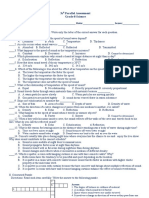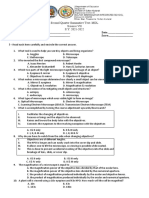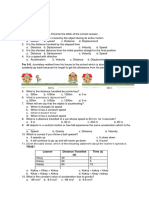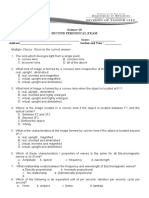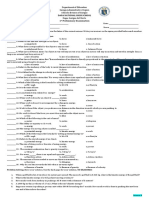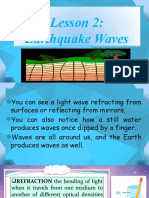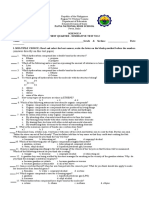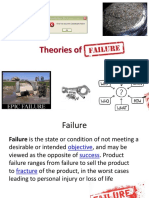100%(1)100% found this document useful (1 vote)
102 viewsSummative Test Work and Energy
Summative Test Work and Energy
Uploaded by
Sha RonThis document appears to be a science test covering concepts of work, energy, and power. It contains multiple choice and free response questions testing understanding of formulas and calculations involving work, kinetic energy, potential energy, force, and other related concepts. The test covers both conceptual and quantitative applications of physics principles.
Copyright:
© All Rights Reserved
Available Formats
Download as DOCX, PDF, TXT or read online from Scribd
Summative Test Work and Energy
Summative Test Work and Energy
Uploaded by
Sha Ron100%(1)100% found this document useful (1 vote)
102 views2 pagesThis document appears to be a science test covering concepts of work, energy, and power. It contains multiple choice and free response questions testing understanding of formulas and calculations involving work, kinetic energy, potential energy, force, and other related concepts. The test covers both conceptual and quantitative applications of physics principles.
Original Title
summative test work and energy
Copyright
© © All Rights Reserved
Available Formats
DOCX, PDF, TXT or read online from Scribd
Share this document
Did you find this document useful?
Is this content inappropriate?
This document appears to be a science test covering concepts of work, energy, and power. It contains multiple choice and free response questions testing understanding of formulas and calculations involving work, kinetic energy, potential energy, force, and other related concepts. The test covers both conceptual and quantitative applications of physics principles.
Copyright:
© All Rights Reserved
Available Formats
Download as DOCX, PDF, TXT or read online from Scribd
Download as docx, pdf, or txt
100%(1)100% found this document useful (1 vote)
102 views2 pagesSummative Test Work and Energy
Summative Test Work and Energy
Uploaded by
Sha RonThis document appears to be a science test covering concepts of work, energy, and power. It contains multiple choice and free response questions testing understanding of formulas and calculations involving work, kinetic energy, potential energy, force, and other related concepts. The test covers both conceptual and quantitative applications of physics principles.
Copyright:
© All Rights Reserved
Available Formats
Download as DOCX, PDF, TXT or read online from Scribd
Download as docx, pdf, or txt
You are on page 1of 2
NAME: ___________________________________ GRADE & SECTION: __________________ DATE: _________ SCORE: _____
SCIENCE 8 – UNIT 1 Module 2 (WORK AND ENERGY) Summative
Directions: Choose the best answer. Encircle the letter of Test 21. Two trailers X with mass 500 kg and Y with mass 2000 kg
your answer. are being pulled at the same speed. The ratio of power
1. Work done is equal to the product of force and exerted by trailer Y to that of X is:
A. distance C. acceleration A. 1:1 B. 2:1 C. 4:1 D. 1:4
B. velocity D. speed 22. What two measurements are needed when calculating
2. It is the capacity or ability to do work. kinetic energy?
A. force B. energy C. power D. work A. velocity and mass C. mass and height
3. According to the scientific definition of work, pushing on a B. acceleration and velocity D. mass and distance
rock accomplishes no work unless there is 23. The metric unit of a joule (J) is a unit of
A. an applied force greater than its weight. A. energy and work C. weight and work
B. a net force greater than zero. B. kinetic and power D. force and energy
C. an opposing force. 24. Which of the following describes power?
D. movement in the same direction as the force A. the rate at which energy is expended
4. Work is not done when B. work per unit of time
A. when displacement is not zero C. the rate at which work is done
B. when force and displacement are parallel D. any of the above
C. when applied force is not zero 25. What is the equation for work done?
D. when force and displacement are perpendicular A. Work done = force / distance
5. It is commonly known as energy at rest.
A. heat energy C. kinetic energy B. Work done = mass x acceleration due to gravity
B. mechanical energy D. potential energy C. Work done = force x distance
6. Which of the following is an example of work being done?
A. a book being pressed against the wall D. Work done = mass x acceleration
B. a book being raised to a high shelf 26. The unit of power is defined as
C. a book being supported at the top of one’s head A. kg•m2/s2 B. Joules C. N/m D. Watt
D. a book lying on the table 27. 1 Joule is equal to .
7. In which of the ff. situations is work done by the given force? A. 1 N B. 1 kg•m2/s2 C. 1 kg•m/s2 D. 1 N2m2
A. a force pushes against an immovable wall 28. A horizontal force of 200 N is applied to move a 55 kg tv
B. the normal force exerted by the table on the book set across a 10 m level surface. How much work done by
C. the force of gravity on the falling mango fruit the force on the tv set?
D. none of these A. 550J B. 2000J C. 6000J D. 11000J
8. An object that has kinetic energy must be. 29. A crate of mass 50kg is pushed along a floor with a force of
A. moving C. falling 20N for a distance of 5m. Calculate the work done.
B. at an elevated position D. at rest A. 2 J B. 100 J C. 5000 J D. 122.5 J
9. Newton•meter is the unit of 30. A football of mass 2.5kg is lifted up to the cliff that is 180m
A. power B. weight C. force D. energy high. How much potential energy does the football gain?
10. Which of the following energy forms is associated with an A. 450 Nm B. 40500 Nm C. 40410 J D. 4410 J
object due to the change in its position? 31. A person of mass 70kg runs up a flight of stairs with a
A. chemical B. kinetic C. mechanical D. potential vertical height of 5m. If the trip takes 7s to complete,
11. If you hold an ordinary rubber ball in your hand at a height calculate his power.
of 3 feet above a smooth concrete floor, at which position A. 49 J/s B. 4.9 J/s C. 4900 J/s D. 490 J/s
will the ball possess lowest potential energy? 32. How much kinetic energy has a 160g cricket ball when it is
A. any point from the holding position thrown at a speed of 22m/s?
B. at three feet A. 38.72 J B. 352 J C. 1.76 J D. 387 J
C. midway between floor and original position 33. A man of mass 50 kg jumps to a height of 1 m. His
D. on the floor potential energy at the highest point is
12. No kinetic energy is possessed by: A. 50 J B. 490 J C. 60 J D. 245 J
A. a shooting star 34. If a balloon does 52 J of work to move a balloon-powered
B. hitting a baseball with a bat toy car to a distance of 10 m, what force does it exert?
C. a rotating propeller on a moving airplane A. 0.19 N B. 20 N C. 5.2 N D. 1352 N
D. an elevator standing at the 5th floor 35. A weightlifter lifts a barbell 1.5 m in 10 s. If he lifts it the
13. A 1-kg block is lifted vertically 1 meter by a boy. How same distance in 20 s, the power made by the weightlifter is:
much work is done by the boy? A. the same C. half as great
A. 1 J B. 9.8 J C. 19.6 J D. zero B. four times as great D. two times as great
14. An object of mass 8.2 kg is moving with a velocity of 4
m/s. Its kinetic energy is: FORMULA DERIVATION: Give the equation directly.
A. 16.4 J B. 65.6 J C. 131.2 J D. none of these 36. Work is calculated by what equation if power and time are
15. Which of the following has the greatest kinetic energy? given? ____________________
A. mass 3m and speed v C. mass 2m and speed 3v 37. What is the formula for final velocity if acceleration, time,
B. mass 3m and speed 2v D. mass m and speed 4v and initial velocity are provided? ____________________
16. Your kinetic energy is directly proportional to the square of 38. What is the formula for time if acceleration, final velocity,
your velocity. If you double your velocity, what happens to and initial velocity are provided? ____________________
your kinetic energy KE? 39. If work and distance are given then force is calculated by
A. KE decreases to two times its original value what equation? ____________________
B. KE increases to two times its original value 40. Give the equation for velocity if kinetic energy and mass
C. KE decreases to four times its original value are given. ____________________
D. KE increases to four times its original value 41. Give the equation for mass if kinetic energy and velocity
17. You push against a rock with force 100 N for 20 s. If the are given. ____________________
rock does NOT move, how much work is done? 42. What is the formula for solving the mass if potential energy
A. zero B. 1 J C. 5 J D. 2000 J and height are given? ____________________
18. A woman lifts a barbell 2.0 m in 5.0 s. If she lifts it the same 43. What is the formula for solving the height if potential energy
distance in 10 s, the work done by her is: and mass are given? ____________________
A. the same C. four times as great
B. half as great D. two times as great PROBLEM SOLVING: Show all your calculations at the
19. A man is pulling a sack of rice towards his house. Which of back of this paper.
the ff. statements describes the situation? 44-46. How far can a mother push a 20.0 kg baby carriage,
A. force is exerted and no work is done on the body using a force of 62 N, if she can only do 2920 J of work?
B. force is exerted and work is done on the body 47-49. A skier with a mass of 88 kg hits a ramp of snow at
C. force is not exerted but work is done 16 m/s and becomes airborne. At the highest point of
D. force is not exerted and no work is done flight, the skier is 3.7 m above the ground. What is the
20. Gravitational potential energy can be calculated by skier’s gravitational potential energy at this point?
A. mh B. mg/h C. mgh D. Wh 50-52.How high up is a 4.5 kg object that has 300 J of energy?
53-55. A 4 kg bird is flying with a velocity of 6 m/s .What is its
kinetic energy?
You might also like
- Physics Pre-AssessmentDocument8 pagesPhysics Pre-Assessmentapi-375738241No ratings yet
- Lecture 31 Quadric SurfacesDocument5 pagesLecture 31 Quadric SurfacesGerrard LarenNo ratings yet
- Sample ExamDocument2 pagesSample ExamJamoi Ray VedastoNo ratings yet
- Rbi-Episode 8 (Q1) Science 8 Learning Competency: Infer The Relationship Between Current and VoltageDocument3 pagesRbi-Episode 8 (Q1) Science 8 Learning Competency: Infer The Relationship Between Current and VoltageTrexie AliaNo ratings yet
- Conservation of Mechanical EnergyDocument5 pagesConservation of Mechanical EnergyJovelo Dela Peña100% (1)
- Summative Test in Science 10 Q2 (EM Waves)Document3 pagesSummative Test in Science 10 Q2 (EM Waves)Marilyn Venturado Era ZataNo ratings yet
- TQ Science10 Q3 ST4Document2 pagesTQ Science10 Q3 ST4mae cudal100% (1)
- CL 10 Physics MCQ Question Bank Chapter 2Document3 pagesCL 10 Physics MCQ Question Bank Chapter 2JoshuaNo ratings yet
- Vectors and ForcesDocument42 pagesVectors and Forcesmukhoro29No ratings yet
- Grade 9 Third Grading Test 2019Document3 pagesGrade 9 Third Grading Test 2019Bing Sepe Culajao0% (1)
- Grade 8 3rd Assessment Sample SampleDocument2 pagesGrade 8 3rd Assessment Sample SampleElaiza TauthoNo ratings yet
- 1st Periodic Test - Science 8Document2 pages1st Periodic Test - Science 8Erwin Mercado100% (1)
- Science 10 - Q1 - W8 - D2Document1 pageScience 10 - Q1 - W8 - D2zenaida a academiaNo ratings yet
- G9 Science ReviewerDocument2 pagesG9 Science ReviewerEZ RioNo ratings yet
- Science 10 - Q2 - Week 1 - M1Document5 pagesScience 10 - Q2 - Week 1 - M1Aaron James Miranda100% (1)
- Periodical TestDocument3 pagesPeriodical TestSalve Gregorio AguirreNo ratings yet
- Gayong-Gayong Sur Integrated School Second Periodic Examination in Science 7 Name: - Date: - ScoreDocument3 pagesGayong-Gayong Sur Integrated School Second Periodic Examination in Science 7 Name: - Date: - ScoreLaira Joy Salvador - ViernesNo ratings yet
- Reflection of Light Activity SheetDocument1 pageReflection of Light Activity SheetEia Rodriguez100% (1)
- What Is Force (Forces Concept Map) L v1 Xz0 s1Document7 pagesWhat Is Force (Forces Concept Map) L v1 Xz0 s1Inform7105No ratings yet
- Q4, Peformance Task #2 - Ener-Vention!Document2 pagesQ4, Peformance Task #2 - Ener-Vention!Ericha Solomon100% (1)
- Newtons Law of Motion WorksheetDocument2 pagesNewtons Law of Motion WorksheetAlyssa Mae DapadapNo ratings yet
- Learning Activity SheetsDocument7 pagesLearning Activity SheetsMei MCNo ratings yet
- 4TH Quarterly Exam Gen Phys2 - Student'sDocument5 pages4TH Quarterly Exam Gen Phys2 - Student'sMark De VeraNo ratings yet
- Detailed Lesson Plan Momentum - Senior HighDocument9 pagesDetailed Lesson Plan Momentum - Senior Highrenantecruz.basc100% (1)
- First Written Test in Science 7 QUARTER 4, SY 2021-2022 Instructions: Read Each Question Carefully and Write The Correct Answer in ADocument6 pagesFirst Written Test in Science 7 QUARTER 4, SY 2021-2022 Instructions: Read Each Question Carefully and Write The Correct Answer in Ajoan marie PeliasNo ratings yet
- Week1 DLL10Document8 pagesWeek1 DLL10Amy Villa100% (1)
- Lesson 1 Intermolecular ForcesDocument36 pagesLesson 1 Intermolecular ForcesCrisanta GanadoNo ratings yet
- ACTIVITY Work Energy and PowerDocument2 pagesACTIVITY Work Energy and PowerMary Rose0% (1)
- Wave Speed Calculations AnswersDocument1 pageWave Speed Calculations Answersjamesoconnell13No ratings yet
- Second Quarter Summative Test-MDL Science VII S.Y. 2021-2022Document4 pagesSecond Quarter Summative Test-MDL Science VII S.Y. 2021-2022ShengNo ratings yet
- ScienceDocument138 pagesScienceDennis100% (1)
- I. MULTIPLE CHOICE. Encircle The Letter of The Correct AnswerDocument3 pagesI. MULTIPLE CHOICE. Encircle The Letter of The Correct AnswerNeil VelascoNo ratings yet
- Q1, C2 Grade 7 Elementary Algebra Test PaperDocument5 pagesQ1, C2 Grade 7 Elementary Algebra Test PaperRuthmae BeeNo ratings yet
- Science10 2nd Quarter ExamDocument2 pagesScience10 2nd Quarter ExamMylene Elvina100% (1)
- 3RD Quarter Exam Grade 7 ScienceDocument2 pages3RD Quarter Exam Grade 7 ScienceJUDITH M. MABAONo ratings yet
- Module 1 Forces and Motion - Topic 1 Uam HorizontalDocument15 pagesModule 1 Forces and Motion - Topic 1 Uam HorizontalCarlos Taroy100% (2)
- Impulse and MomentumDocument31 pagesImpulse and MomentumFrancisQuiwaNo ratings yet
- Week 2 3 Mirror 21 22.pptx 1Document90 pagesWeek 2 3 Mirror 21 22.pptx 1clairearabelle iloyNo ratings yet
- Charles' LawDocument4 pagesCharles' LawGarren Jude Aquino100% (1)
- Science 8 - Prelim ExamDocument3 pagesScience 8 - Prelim Examjoan marie PeliasNo ratings yet
- Worksheet 3 Vertical MotionSSCDocument1 pageWorksheet 3 Vertical MotionSSCKyle HernandoNo ratings yet
- Summative Test Science 7Document2 pagesSummative Test Science 7Bik BokNo ratings yet
- Sci-8 SSLM Q2 W7Document7 pagesSci-8 SSLM Q2 W7QUEENIE JAM ABENOJANo ratings yet
- Science 8-Quarter 2-Lesson 2Document24 pagesScience 8-Quarter 2-Lesson 2Ms. Rhonabelle Llerin PagudNo ratings yet
- Summative Test #4GRADE 8Document2 pagesSummative Test #4GRADE 8Emily Tatunay EspejoNo ratings yet
- Pasay S9LT Q1 W3 4 04Document6 pagesPasay S9LT Q1 W3 4 04Frederick EspejoNo ratings yet
- 1st SUMMATIVE TEST IN SCIENCE 10 Q2Document6 pages1st SUMMATIVE TEST IN SCIENCE 10 Q2Sabnahis Batongbuhay ExtensionNo ratings yet
- Science 8 - Module 8 - Version 3Document9 pagesScience 8 - Module 8 - Version 3buena fe chavezNo ratings yet
- Light CrosswordDocument2 pagesLight CrosswordGel LeeNo ratings yet
- Crossword VolcanoDocument2 pagesCrossword VolcanoraquelcoferNo ratings yet
- General Physics 2: Activity Title: Electricity Activity No.: 4.1 Learning CompetencyDocument5 pagesGeneral Physics 2: Activity Title: Electricity Activity No.: 4.1 Learning CompetencyLeonardo PigaNo ratings yet
- Summative Test Grade - 9: Direction: Read and Answer The Following Questions Carefully. Encircle Your AnswerDocument1 pageSummative Test Grade - 9: Direction: Read and Answer The Following Questions Carefully. Encircle Your Answeralvin n. vedarozagaNo ratings yet
- Lagare, Cabanatuan City: ST NDDocument1 pageLagare, Cabanatuan City: ST NDRon Adrian Sarte SebastianNo ratings yet
- Science 8 2nd Quarter (Online)Document2 pagesScience 8 2nd Quarter (Online)Qasa GoldNo ratings yet
- Science 10 - Q2 - W6 - D3Document1 pageScience 10 - Q2 - W6 - D3zenaida a academiaNo ratings yet
- Quiz On ElectromagnetismDocument2 pagesQuiz On ElectromagnetismAllan RoyNo ratings yet
- Daily Lesson Log Grade 10 2nd Week 2Document6 pagesDaily Lesson Log Grade 10 2nd Week 2Queeny Pantoja-HondradaNo ratings yet
- SCIENCE 8 Q1 W4 1 Law of Action-ReactionDocument4 pagesSCIENCE 8 Q1 W4 1 Law of Action-ReactionMICAH NORADANo ratings yet
- Science 7 Summative Test With TosDocument2 pagesScience 7 Summative Test With TosOSZEL JUNE BALANAYNo ratings yet
- Science 9 Summative Test 1Document2 pagesScience 9 Summative Test 1Ma. Socorro HilarioNo ratings yet
- 2ND Periodic Exam SHSDocument7 pages2ND Periodic Exam SHSshirley cortezNo ratings yet
- Summative Test Heat and TemperatureDocument2 pagesSummative Test Heat and TemperatureSha RonNo ratings yet
- Light and Sound SummativeDocument1 pageLight and Sound SummativeSha RonNo ratings yet
- Forces On Objects at RestDocument1 pageForces On Objects at RestSha RonNo ratings yet
- Adaptive Learning: Maria Clariza J. OquiasDocument26 pagesAdaptive Learning: Maria Clariza J. OquiasSha RonNo ratings yet
- LRMDS School Based2finalDocument51 pagesLRMDS School Based2finalSha RonNo ratings yet
- JOURNEY OF FOOD-picture AnalysisDocument1 pageJOURNEY OF FOOD-picture AnalysisSha RonNo ratings yet
- G8 Q4 Bio ReviewedDocument5 pagesG8 Q4 Bio ReviewedSha RonNo ratings yet
- Carbonate Acidizing - A Mechanistic Model For Wormhole Growth in Linear and Radial FlowDocument25 pagesCarbonate Acidizing - A Mechanistic Model For Wormhole Growth in Linear and Radial FlowNatalino SouzaNo ratings yet
- EngineeringMechanics CH01 Technical TermsDocument4 pagesEngineeringMechanics CH01 Technical TermsJhaybi LacapNo ratings yet
- Heat Treatment Lecture 1Document19 pagesHeat Treatment Lecture 1Solcastic SoulNo ratings yet
- Electrical Machines-IiDocument47 pagesElectrical Machines-IiSunilkumarNo ratings yet
- Analysis of The "3-Omega" Method For Substrates and Thick Films of Anisotropic Thermal ConductivityDocument9 pagesAnalysis of The "3-Omega" Method For Substrates and Thick Films of Anisotropic Thermal ConductivityTriều Huỳnh NhậtNo ratings yet
- Gregory H. Wannier - Statistical Physics-Dover Publ. (1987) PDFDocument564 pagesGregory H. Wannier - Statistical Physics-Dover Publ. (1987) PDFJosé Vellojín100% (1)
- Cambridge Primary Science 0097 Curriculum FrameworkDocument4 pagesCambridge Primary Science 0097 Curriculum Frameworkkaurpurva6No ratings yet
- MEC3074F Course Hand Out 2024Document4 pagesMEC3074F Course Hand Out 2024Frank CobaltinNo ratings yet
- Swarm Intelligent AgentsDocument153 pagesSwarm Intelligent AgentsCamila G. Hidalgo M.No ratings yet
- Yang-Mills Instantons and The S-Matrix (1979)Document19 pagesYang-Mills Instantons and The S-Matrix (1979)oldmanbearsNo ratings yet
- Structural Analysis AND Design ComputationDocument20 pagesStructural Analysis AND Design ComputationJheo TorresNo ratings yet
- Do Birds Vocalize at Higher Pitch in Noise, or Is It A Matter of Measurement?Document13 pagesDo Birds Vocalize at Higher Pitch in Noise, or Is It A Matter of Measurement?Sebas Felipe OrtegaNo ratings yet
- Theories of FailureDocument25 pagesTheories of FailureLucia LephotoNo ratings yet
- Laser Distance Sensor Modules DatasheetDocument4 pagesLaser Distance Sensor Modules DatasheetZhuoqun DaiNo ratings yet
- The CIRCUIT DESCRIPTION CODE (CDC) ExplainedDocument8 pagesThe CIRCUIT DESCRIPTION CODE (CDC) Explainedfirulenchi6969No ratings yet
- Willi-Hans Steeb, Yorick Hardy - Problems and Solutions in Quantum Computing and Quantum Information-WSPC (2018)Document554 pagesWilli-Hans Steeb, Yorick Hardy - Problems and Solutions in Quantum Computing and Quantum Information-WSPC (2018)ayush100% (1)
- Full Chapter Cellular Mechanics and Biophysics Structure and Function of Basic Cellular Components Regulating Cell Mechanics Claudia Tanja Mierke PDFDocument54 pagesFull Chapter Cellular Mechanics and Biophysics Structure and Function of Basic Cellular Components Regulating Cell Mechanics Claudia Tanja Mierke PDFjasmine.martin597100% (10)
- CBSE Sample Paper Class 12 Physics Set 3: All Questions Are Compulsory. There Are 27 Questions in AllDocument4 pagesCBSE Sample Paper Class 12 Physics Set 3: All Questions Are Compulsory. There Are 27 Questions in AllI dont have a NameNo ratings yet
- Newton's Third Law of MotionDocument27 pagesNewton's Third Law of MotionJayhia Malaga JarlegaNo ratings yet
- MAB 104B-14 - 104B-24 - Manual - 2000Document167 pagesMAB 104B-14 - 104B-24 - Manual - 2000Centrifugal Separator100% (1)
- FIITJEE - JEE (Main) 2Document12 pagesFIITJEE - JEE (Main) 2Aditya JainNo ratings yet
- Selección Del Ventilador - AXC-355A 4P 60Hz Fan PerformanceDocument2 pagesSelección Del Ventilador - AXC-355A 4P 60Hz Fan PerformanceDiego RomeroNo ratings yet
- Maths Books Pearson Education Maths (Hinglish) StatisticsDocument140 pagesMaths Books Pearson Education Maths (Hinglish) Statisticsragini reddyNo ratings yet
- High-Lift: System AerodynamicsDocument513 pagesHigh-Lift: System AerodynamicsJinNo ratings yet
- Light and DarkDocument5 pagesLight and DarkpriyaNo ratings yet
- HYDROPOWER - Robbie Edward SayersDocument36 pagesHYDROPOWER - Robbie Edward Sayersrobbie.sayers01No ratings yet
- An Experimental Study On Strength Behavi PDFDocument4 pagesAn Experimental Study On Strength Behavi PDFBenson Mwathi MungaiNo ratings yet
- Structural Auditof BuildingsDocument5 pagesStructural Auditof BuildingsRaphael Thumbi100% (1)
- Welltest Summary: Pt. Putra Sejati IndomakmurDocument18 pagesWelltest Summary: Pt. Putra Sejati IndomakmurAditya FathurachmanNo ratings yet










